UNITED STATES
SECURITIES AND EXCHANGE COMMISSION
Washington, D.C. 20549
FORM N-CSR
CERTIFIED SHAREHOLDER REPORT OF REGISTERED
MANAGEMENT INVESTMENT COMPANIES
Investment Company Act File Number: 811-04521
| T. Rowe Price State Tax-Free Income Trust |
|
| (Exact name of registrant as specified in charter) |
| |
| 100 East Pratt Street, Baltimore, MD 21202 |
|
| (Address of principal executive offices) |
| |
| David Oestreicher |
| 100 East Pratt Street, Baltimore, MD 21202 |
|
| (Name and address of agent for service) |
Registrant’s telephone number, including area code: (410) 345-2000
Date of fiscal year end: February 28
Date of reporting period: February 28, 2014
Item 1. Report to Shareholders
| Georgia Tax-Free Bond Fund | February 28, 2014 |
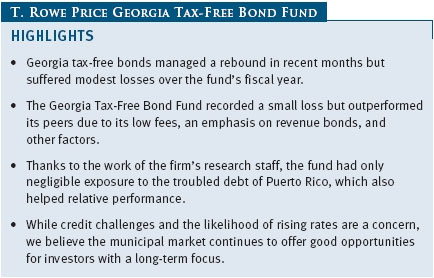
The views and opinions in this report were current as of February 28, 2014. They are not guarantees of performance or investment results and should not be taken as investment advice. Investment decisions reflect a variety of factors, and the managers reserve the right to change their views about individual stocks, sectors, and the markets at any time. As a result, the views expressed should not be relied upon as a forecast of the fund’s future investment intent. The report is certified under the Sarbanes-Oxley Act, which requires mutual funds and other public companies to affirm that, to the best of their knowledge, the information in their financial reports is fairly and accurately stated in all material respects.
REPORTS ON THE WEB
Sign up for our E-mail Program, and you can begin to receive updated fund reports and prospectuses online rather than through the mail. Log in to your account at troweprice.com for more information.
Manager’s Letter
Fellow Shareholders
Tax-free municipal bond returns were narrowly mixed in the one-year period ended February 28, 2014, as strong gains in the last six months mostly offset losses in the first half of our fiscal year. Intermediate- and long-term Treasury interest rates increased over the last year amid moderate economic growth and expectations that the Federal Reserve would start to reduce the size of its monthly asset purchases—which it did at the beginning of 2014. Longer-term municipal interest rates also increased over the last year, while shorter-term yields were little changed. While its absolute returns over the fiscal year were disappointing, we are pleased to report that the Georgia Tax-Free Bond Fund enjoyed a rebound in recent months and outperformed its peer group average.
ECONOMY AND INTEREST RATES
Despite higher federal tax rates and spending cuts at the beginning of 2013, the U.S. economy grew at a moderate pace over the last 12 months. Gross domestic product expanded at a 4.1% annualized rate in the third quarter of 2013, the highest rate in about two years, and at a milder 2.4% rate in the fourth quarter, in part because of weaker-than-expected consumer spending. Still, steady job growth helped reduce the national unemployment rate to 6.7% in February. We anticipate that the U.S. economic recovery will strengthen in 2014, as last year’s fiscal policy headwinds subside and wage growth improves.
To support the recovery, the Federal Reserve purchased $45 billion in Treasuries and $40 billion in agency mortgage-backed securities every month in 2013 to suppress longer-term rates. In both January and February 2014, however, the Fed reduced the size of its monthly purchases by $10 billion. We anticipate that the Fed will announce similar reductions after future monetary policy meetings, with asset purchases likely to end by the close of 2014. While Fed tapering may result in higher long-term interest rates, short-term rate increases seem unlikely to occur until sometime in late 2015 or 2016.
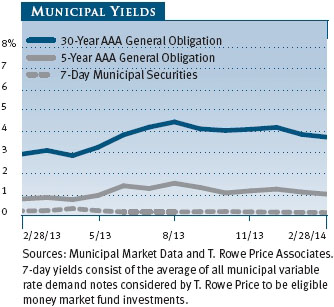
The Treasury and municipal yield curves steepened over the last year: Long-term yields increased as the taper approached, while short-term rates remained anchored by the Fed’s commitment to keep them low even after the unemployment rate drops below 6.5%—assuming inflation remains contained. However, high-quality 30-year municipal yields rose more than the 30-year Treasury yield, which is unusual, and were slightly higher than the 30-year Treasury yield at the end of our reporting period. On a relative basis, this demonstrates the attractiveness of long-term tax-free bonds as an alternative for fixed income investors.
As of February 28, 2014, the 3.72% yield offered by a 30-year tax-free bond rated AAA was about 104% of the 3.58% pretax yield offered by a 30-year Treasury bond. An investor in the 28% federal tax bracket would need to invest in a taxable bond yielding about 5.17% to receive the same after-tax income. (To calculate a municipal bond’s taxable-equivalent yield, divide the municipal bond’s yield by the quantity of 1.00 minus your federal tax bracket expressed as a decimal—in this case, 1.00 – 0.28, or 0.72.)
MUNICIPAL MARKET NEWS
Full-year municipal issuance in 2013 totaled about $330 billion versus about $380 billion in 2012, according to The Bond Buyer, while issuance in the first two months of 2014 has been lower than expected, at around $34 billion. Issuance since mid-2013 has been somewhat limited, as higher long-term interest rates discouraged municipalities from refinancing older debt. Outflows from the municipal market persisted throughout the second half of 2013, and rising rates and credit concerns in certain parts of the muni market restrained demand from individual investors during that period. These trends abated somewhat in the first two months of 2014, but a resumption of rising rates or cash flows out of municipal bond portfolios could weigh on the market.
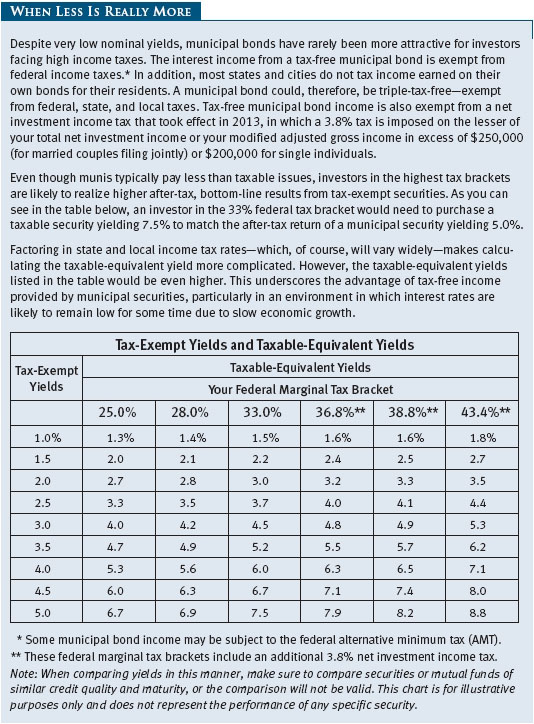
Austerity-minded state and local government leaders remain conservative about adding to indebtedness, which we consider to be supportive. Indeed, most states have acted responsibly in the last few years by cutting spending and raising taxes and fees to close budget deficits. While state tax revenues are growing again, the pattern has been slower and more uneven than historically, and expense pressures continue. We believe that many states deserve high credit ratings and that state governments will be able to continue servicing their outstanding debts. However, we have longer-term concerns about some states’ willingness and ability to address sizable pension obligations and other retirement benefits.
Detroit’s Chapter 9 bankruptcy case, while not an indicator of a systemic breakdown in municipal credit fundamentals, remains a concern for municipal investors. The judge in the case has ruled that the city is eligible for bankruptcy and that pension benefits—even though they are protected by the Michigan Constitution—could be reduced through the federal bankruptcy process.
Also, the deteriorating fiscal situation in the Commonwealth of Puerto Rico, as highlighted in the media and as indicated by recent credit rating agency downgrades to below investment grade, is still a risk to the broader muni market. This U.S. territory’s liabilities are large relative to the size of its economy, with close to $50 billion of municipal debt outstanding and over $70 billion of general indebtedness for the commonwealth and its various governmental agencies. We continue to have very low exposure to Puerto Rico and would not be surprised if there are additional downgrades or if the commonwealth seeks a debt restructuring in the next year or two. Puerto Rico’s $3.5 billion bond issuance in early March will provide some stability in the short run, but over the long term, the commonwealth’s government will need to continue to make difficult decisions in order to improve its fiscal and economic profile.
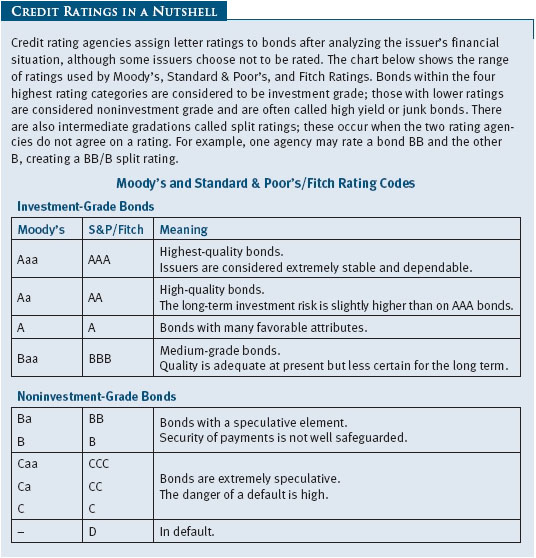
In terms of sector performance, state and local general obligations (GOs) were flat but held up better than revenue bonds over the last 12 months. We favor bonds backed by a dedicated revenue stream over GOs, with a bias toward transportation and utility bonds issued by these essential service providers. Among revenue bonds, special tax and power bonds were two of the worst-performing sectors for the year due to weakness in Puerto Rican issues. Most remaining revenue segments were flat, but housing bonds outperformed with mild gains, helped by the residential real estate recovery.
Georgia Market News
Georgia is showing signs of an upturn in personal income and tax collections, driven by better employment statistics. The state’s unemployment rate stood at 7.4% in December 2013 (all figures refer to the latest data available), an improvement from 8.7% in December 2012. While Georgia’s unemployment rate remains above the national average, growth in Georgians’ personal income is now on par with national trends. The state’s median household income level is slightly below the U.S. average but appears more favorable when taking into account cost-of-living and quality-of-life indicators.
The modest turnaround in the state’s economy has resulted in a somewhat more substantial improvement in the state’s finances. During fiscal year 2013, Georgia’s general fund revenues were up 5% from fiscal 2012, with most of the improvement attributable to personal income tax receipts. Georgia accumulated a 2% surplus in its general fund in fiscal 2013. For the first six months of fiscal year 2014, which began on July 1, 2013, general fund tax revenues were up 5% from the previous year. Georgia’s fiscal year 2014 budget is balanced and was finalized on time, while the fiscal year 2015 budget is progressing toward approval and is balanced as proposed.
Throughout the downturn and first stages of recovery, Georgia’s finances have benefited from prudent management during the economic expansion that came to an end in 2007. During the recession, Georgia was proactive in cutting expenses but also used up most of its rainy-day funds, which had reached a peak of $1.7 billion (9% of revenues) in June 2007. The fund subsequently fell sharply but has since been replenished somewhat, reaching $900 million (5% of revenues) as of June 30, 2013.
Unlike some other states, Georgia does not face a crisis in pension liabilities. The most recent disclosures date back to June 30, 2012, but indicate that Georgia’s employee pension fund was funded at 69% on a market value basis. The state’s fund for teachers was funded at 78% as of the same date. The unfunded portions of the two plans were a manageable $5 billion and $15 billion, respectively. Georgia’s unfunded liability for other post-employment benefits was high, however, at $4 billion for its employees and $11 billion for school personnel. Various plan design changes were enacted from 2009 to 2011 to reduce these unfunded retirement liabilities.
Georgia’s Constitution should also guarantee that the state’s debt levels remain acceptable. The state’s maximum annual debt service is limited to 10% of total revenue receipts. The state has also established “debt affordability” limits, which provide that outstanding debt will not exceed 2.7% of personal income and that debt service will not exceed 5% of the prior year’s revenues. The state currently has some room under these ceilings.
Responsible fiscal management and the safeguards provided by the state constitution have allowed Georgia to maintain its high credit ratings even in the face of the last sharp economic slowdown. As of March 12, 2014, the state’s GO bonds were rated AAA, with a stable outlook, by all three of the major rating agencies.
PERFORMANCE AND PORTFOLIO STRATEGY
The Georgia Tax-Free Bond Fund returned -0.77% in its fiscal year ended February 28, 2014, with a gain of 6.07% in the last six months nearly compensating for the losses in the first half of our fiscal year. Our strong performance relative to the benchmark benefited from our yield curve positioning, an emphasis on revenue bonds, our limited exposure to Puerto Rico, and the fund’s low fees. Our conservative overall interest rate positioning, which included an above-average allocation to cash and short-term investments, detracted modestly. (Based on cumulative total return, Lipper ranked the Georgia Tax-Free Bond Fund 49 of 260, 29 of 257, 60 of 239, and 46 of 202 funds in the other states municipal debt funds category for the 1-, 3-, 5-, and 10-year periods ended February 28, 2014, respectively. Please note that Lipper has discontinued the “Georgia municipal debt funds” category and is now classifying the fund in its broader “other states” category. Past performance cannot guarantee future results.)

The fund’s returns rebounded sharply over the past six months. Despite broader credit concerns focused on problems with Detroit and Puerto Rico, gains for the fund and market were driven by a sharp decline in long- and intermediate-term municipal bond yields. Even with the decline in yields, however, the fund’s dividends per share remained constant over the past six months, at $0.19.
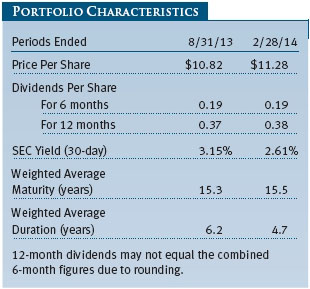
Although we kept the portfolio’s emphasis on longer-term securities, we trimmed our exposure to such issues slightly. Holding fewer longer-term issues reduced the interest rate sensitivity of the portfolio, which was reflected in a significant decline in the portfolio’s duration. As shown in the Portfolio Characteristics table, duration declined from 6.2 years at the end of last August to 4.7 years at the end of February. This positioning detracted a bit from relative performance over the last six months as interest rates fell. Nevertheless, we plan to maintain this more conservative profile, as we expect the upward pressure on rates will resume over the next year or two.
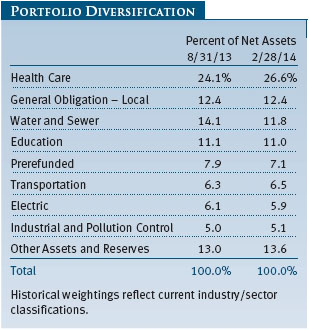
In terms of our sector positioning, we continued our emphasis on revenue sectors. We are attracted to the relative security of specific claims on revenues versus generic pledges of taxing power associated with GOs, and revenue sectors typically also provide more yield. Over the past six months, we actively sought new holdings in the health care sector, which we believe is a perennially good source of yield in the municipal market. Hospitals and long-term care facilities are important issuers in the segment, and we added a new position in Savannah’s Marshes of Skidaway Island, which replaced an older position that was called from the portfolio. (Please refer to the fund’s portfolio of investments for a complete list of our holdings and the amount each represents in the portfolio.)
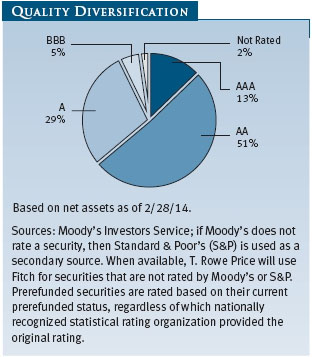
Finally, the fund’s negligible exposure to the debt of Puerto Rico as our fiscal year began was a boon to relative performance. Bonds from the commonwealth are widely held because their income is tax-exempt in all states. As discussed earlier, however, these issues performed very poorly over the past year as the precarious state of Puerto Rico’s finances became generally recognized. Our ability to avoid this pitfall can be credited to our strong research team, which guided us well.
OUTLOOK
The decline in municipal bond prices that we witnessed during 2013 has rattled some investors, but it does not represent a fundamental change in the nature, quality, or risk characteristics of the market. We continue to believe that it is a high-quality market, with good investment opportunities for those with a long-term focus—particularly those in the highest tax brackets—in what is still a very low interest rate environment. The underperformance of long-term munis has made their nominal and taxable-equivalent yields more attractive, but price declines are likely if market outflows resume and interest rates start rising again.
We have been concerned about the potential for rising rates for some time. Our interest rate strategy and economics teams regularly make forward-looking projections of rates and yield curves, and we incorporate these assessments in our investment strategies. Given the potential for rates to rise further, we will remain careful with any investment shift that might materially increase our portfolio’s interest rate sensitivity. However, we believe further rate increases will be more modest than what we have seen since the spring of 2013.
Irrespective of interest rate movements, the credit and economic environment for municipalities is starting to get better but could remain challenging. Modest economic growth and improving income and sales tax revenues are providing some support for state and local governments. Also, improvements in the health of the real estate market should translate into stabilizing property tax revenues for local governments.
State and local government liabilities such as pension benefits and health care costs are a growing long-term concern. While most municipal governments are maintaining balanced budgets, fewer municipalities have addressed these longer-term liabilities meaningfully. States will need to continue these efforts on their own, as a federal bailout of state and local governments without some losses to bondholders seems unlikely. We continue to monitor Detroit’s bankruptcy proceedings closely because there is the potential for adverse legal precedents to arise out of the case. As for Puerto Rico, our dedication to thorough, fundamental credit research has helped us minimize our exposure to this increasingly risky yet significant issuer of municipal bonds. Puerto Rico is working hard to turn its fiscal situation around, but significant challenges remain, and a debt restructuring seems likely without a strong economic rebound.
We believe T. Rowe Price’s strong credit research capabilities have been, and will remain, an asset for our investors. Even as interest rates return to more normal levels, bonds will remain an important asset class, and we expect to continue finding good investment opportunities for long-term oriented, income-seeking investors. We continue to conduct thorough research and assign our own independent credit ratings before making investment decisions. As always, we are on the lookout for attractively valued bonds issued by municipalities with good long-term fundamentals—an investment strategy that we believe will continue to serve our long-term investors well.
Respectfully submitted,

Hugh D. McGuirk
Chairman of the Investment Advisory Committee
March 13, 2014
The committee chairman has day-to-day responsibility for managing the portfolio and works with committee members in developing and executing the fund’s investment program.
RISKS OF INVESTING
As with all mutual funds, the fund’s share price can fall because of weakness in the markets, a particular industry, or specific holdings. Yield and share price will vary with interest rate changes. Investors should note that if interest rates rise significantly from current levels, the fund’s share price will decline and may even turn negative in the short term. There is also a chance that some of the fund’s holdings may have their credit rating downgraded or may default. The fund is less diversified than one investing nationally. Some income may be subject to state and local taxes and the federal alternative minimum tax.
GLOSSARY
Barclays Municipal Bond Index: An unmanaged index that includes investment-grade, tax-exempt, and fixed rate bonds.
Duration: A measure of a bond fund’s sensitivity to changes in interest rates. For example, a fund with a duration of six years would fall about 6% in price in response to a one-percentage-point rise in interest rates and vice versa.
General obligation debt: A government’s strongest pledge that obligates its full faith and credit, including, if necessary, its ability to raise taxes.
Gross domestic product: The total market value of all goods and services produced in a country in a given year.
Investment grade: High-quality bonds as measured by one of the major credit rating agencies. For example, Standard & Poor’s designates the bonds in its top four categories (AAA to BBB) as investment grade.
Lipper averages: The averages of available mutual fund performance returns for specified time periods in categories defined by Lipper Inc.
Prerefunded bond: A bond that originally may have been issued as a general obligation or revenue bond but that is now secured by an escrow fund consisting entirely of direct U.S. government obligations that are sufficient for paying the bondholders.
Revenue bonds: Bonds issued to fund specific projects, such as airports, bridges, hospitals, and toll roads, where a portion of the revenue generated is used to service the interest payments on the bonds.
SEC yield (30-day): A method of calculating a fund’s yield that assumes all portfolio securities are held until maturity. The Securities and Exchange Commission (SEC) requires all bond funds to calculate this yield. Yield will vary and is not guaranteed.
Weighted average maturity: A measure of a fund’s interest rate sensitivity. In general, the longer the average maturity, the greater the fund’s sensitivity to interest rate changes. The weighted average maturity may take into account the interest rate readjustment dates for certain securities.
Yield curve: A graphic depiction of the relationship between yields and maturity dates for a set of similar securities, such as Treasuries or municipal securities. Securities with longer maturities usually have a higher yield. If short-term securities offer a higher yield, then the curve is said to be “inverted.” If short- and long-term bonds are offering equivalent yields, then the curve is said to be “flat.”
Performance and Expenses
This chart shows the value of a hypothetical $10,000 investment in the fund over the past 10 fiscal year periods or since inception (for funds lacking 10-year records). The result is compared with benchmarks, which may include a broad-based market index and a peer group average or index. Market indexes do not include expenses, which are deducted from fund returns as well as mutual fund averages and indexes.
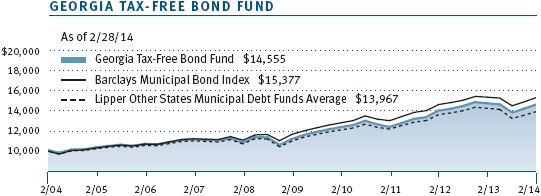
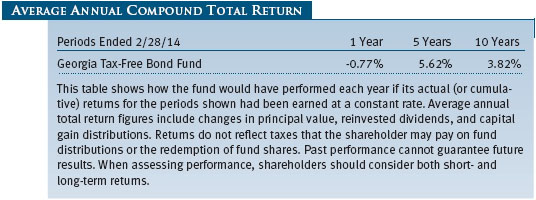
As a mutual fund shareholder, you may incur two types of costs: (1) transaction costs, such as redemption fees or sales loads, and (2) ongoing costs, including management fees, distribution and service (12b-1) fees, and other fund expenses. The following example is intended to help you understand your ongoing costs (in dollars) of investing in the fund and to compare these costs with the ongoing costs of investing in other mutual funds. The example is based on an investment of $1,000 invested at the beginning of the most recent six-month period and held for the entire period.
Actual Expenses
The first line of the following table (Actual) provides information about actual account values and expenses based on the fund’s actual returns. You may use the information on this line, together with your account balance, to estimate the expenses that you paid over the period. Simply divide your account value by $1,000 (for example, an $8,600 account value divided by $1,000 = 8.6), then multiply the result by the number on the first line under the heading “Expenses Paid During Period” to estimate the expenses you paid on your account during this period.
Hypothetical Example for Comparison Purposes
The information on the second line of the table (Hypothetical) is based on hypothetical account values and expenses derived from the fund’s actual expense ratio and an assumed 5% per year rate of return before expenses (not the fund’s actual return). You may compare the ongoing costs of investing in the fund with other funds by contrasting this 5% hypothetical example and the 5% hypothetical examples that appear in the shareholder reports of the other funds. The hypothetical account values and expenses may not be used to estimate the actual ending account balance or expenses you paid for the period.
Note: T. Rowe Price charges an annual account service fee of $20, generally for accounts with less than $10,000. The fee is waived for any investor whose T. Rowe Price mutual fund accounts total $50,000 or more; accounts electing to receive electronic delivery of account statements, transaction confirmations, prospectuses, and shareholder reports; or accounts of an investor who is a T. Rowe Price Preferred Services, Personal Services, or Enhanced Personal Services client (enrollment in these programs generally requires T. Rowe Price assets of at least $100,000). This fee is not included in the accompanying table. If you are subject to the fee, keep it in mind when you are estimating the ongoing expenses of investing in the fund and when comparing the expenses of this fund with other funds.
You should also be aware that the expenses shown in the table highlight only your ongoing costs and do not reflect any transaction costs, such as redemption fees or sales loads. Therefore, the second line of the table is useful in comparing ongoing costs only and will not help you determine the relative total costs of owning different funds. To the extent a fund charges transaction costs, however, the total cost of owning that fund is higher.
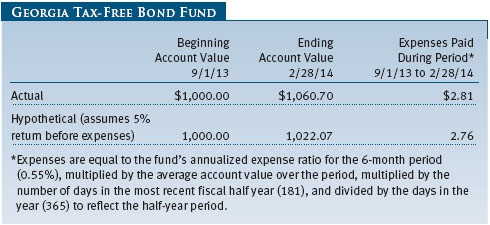
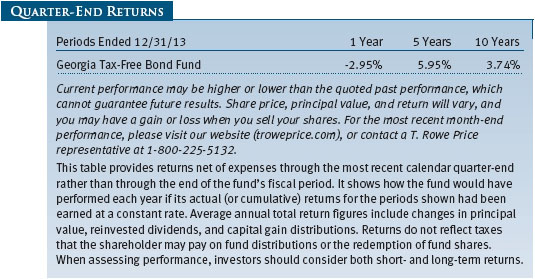

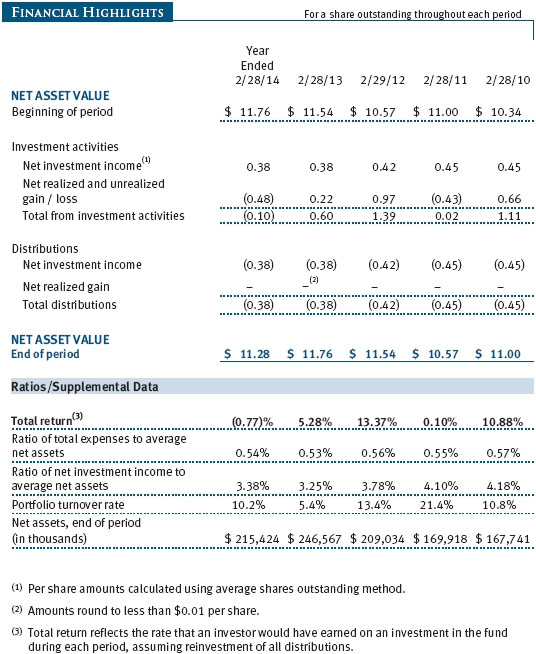
The accompanying notes are an integral part of these financial statements.
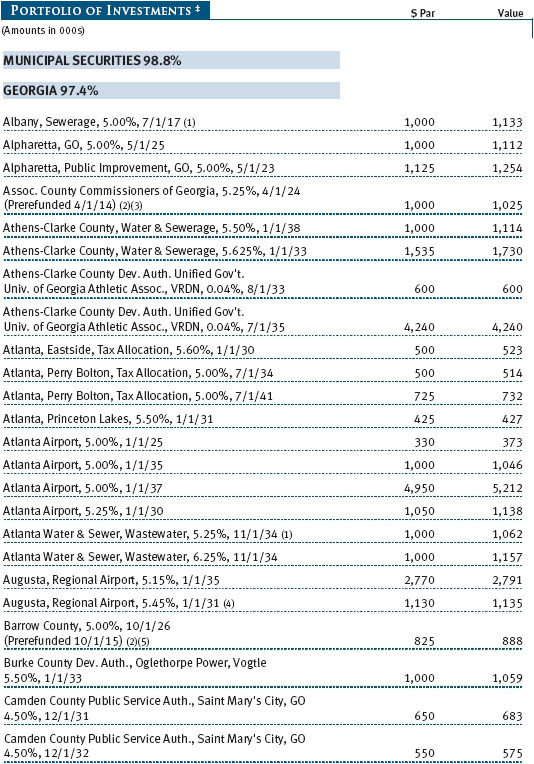
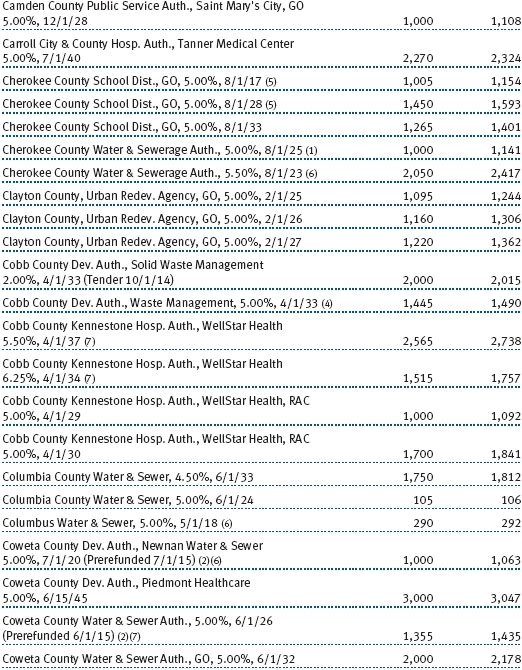
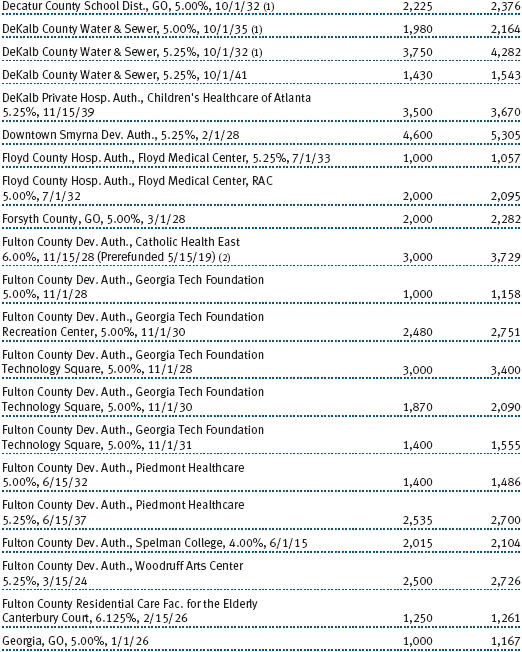
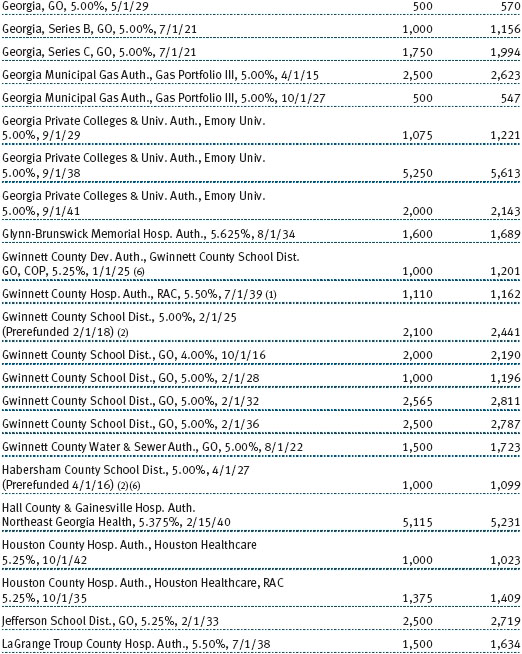
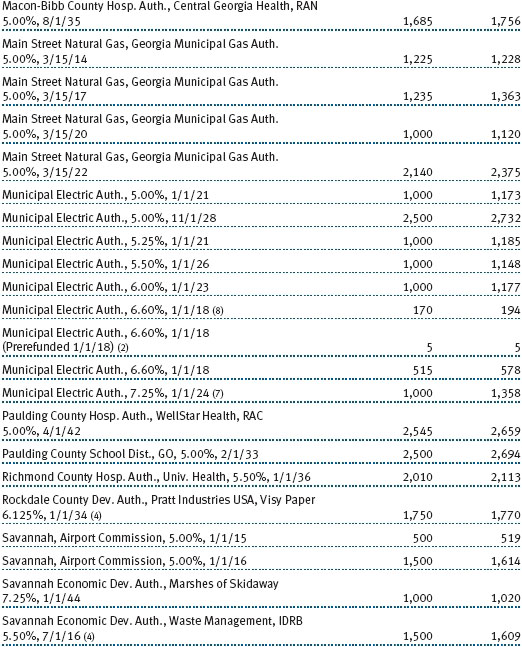
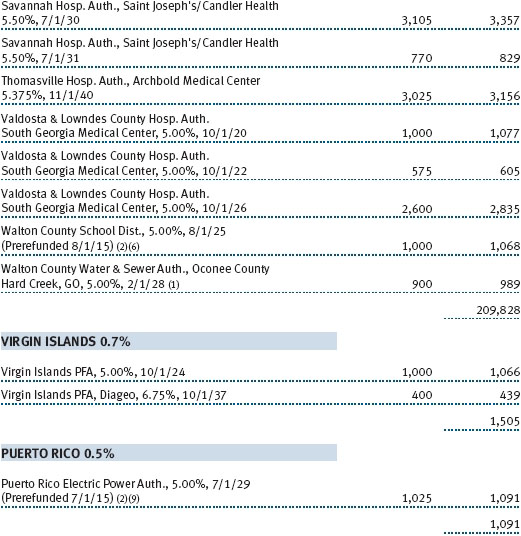
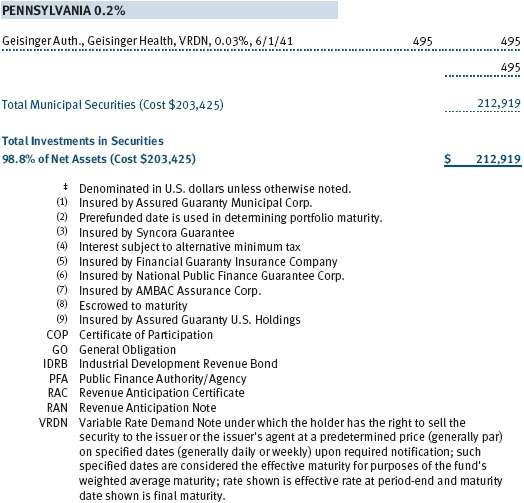
The accompanying notes are an integral part of these financial statements.
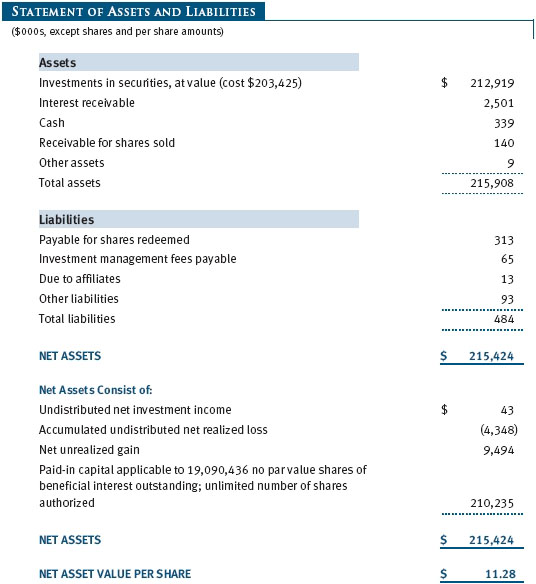
The accompanying notes are an integral part of these financial statements.
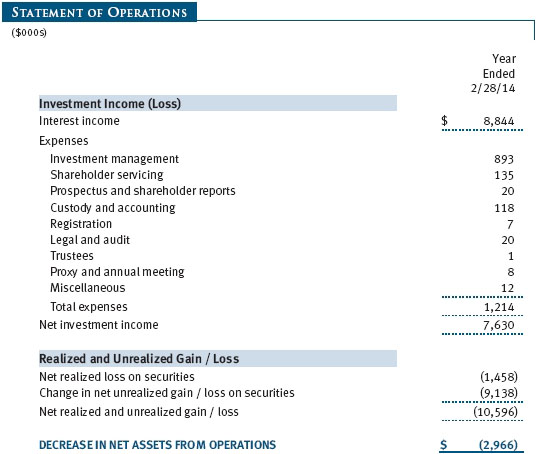
The accompanying notes are an integral part of these financial statements.
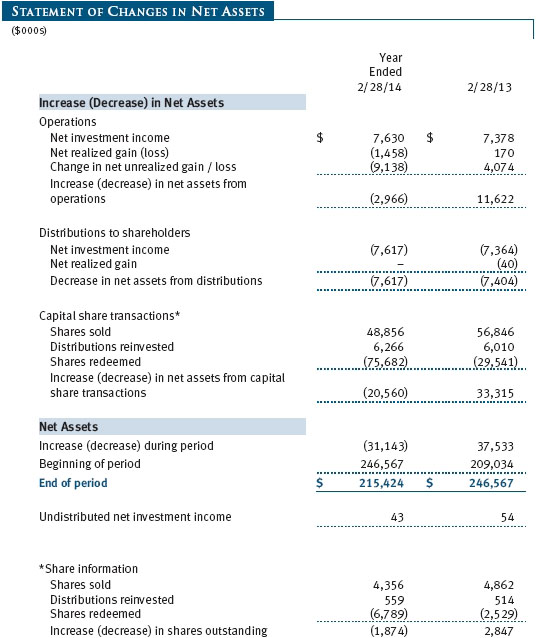
The accompanying notes are an integral part of these financial statements.
| Notes to Financial Statements |
T. Rowe Price State Tax-Free Income Trust (the trust), is registered under the Investment Company Act of 1940 (the 1940 Act). The Georgia Tax-Free Bond Fund (the fund) is a nondiversified, open-end management investment company established by the trust. The fund commenced operations on March 31, 1993. The fund seeks to provide, consistent with prudent portfolio management, the highest level of income exempt from federal and Georgia state income taxes by investing primarily in investment-grade Georgia municipal bonds.
NOTE 1 - SIGNIFICANT ACCOUNTING POLICIES
Basis of Preparation The fund is an investment company and follows accounting and reporting guidance in the Financial Accounting Standards Board Accounting Standards Codification Topic 946 (ASC 946). The accompanying financial statements were prepared in accordance with accounting principles generally accepted in the United States of America (GAAP), including but not limited to ASC 946. GAAP requires the use of estimates made by management. Management believes that estimates and valuations are appropriate; however, actual results may differ from those estimates, and the valuations reflected in the accompanying financial statements may differ from the value ultimately realized upon sale or maturity.
Investment Transactions, Investment Income, and Distributions Income and expenses are recorded on the accrual basis. Premiums and discounts on debt securities are amortized for financial reporting purposes. Income tax-related interest and penalties, if incurred, would be recorded as income tax expense. Investment transactions are accounted for on the trade date. Realized gains and losses are reported on the identified cost basis. Distributions to shareholders are recorded on the ex-dividend date. Income distributions are declared daily and paid monthly. Capital gain distributions, if any, are generally declared and paid by the fund annually.
Credits The fund earns credits on temporarily uninvested cash balances held at the custodian, which reduce the fund’s custody charges. Custody expense in the accompanying financial statements is presented before reduction for credits.
NOTE 2 - VALUATION
The fund’s financial instruments are valued, and its net asset value (NAV) per share is computed at the close of the New York Stock Exchange (NYSE), normally 4 p.m. ET, each day the NYSE is open for business.
Fair Value The fund’s financial instruments are reported at fair value, which GAAP defines as the price that would be received to sell an asset or paid to transfer a liability in an orderly transaction between market participants at the measurement date. The T. Rowe Price Valuation Committee (the Valuation Committee) has been established by the fund’s Board of Trustees (the Board) to ensure that financial instruments are appropriately priced at fair value in accordance with GAAP and the 1940 Act. Subject to oversight by the Board, the Valuation Committee develops and oversees pricing-related policies and procedures and approves all fair value determinations. Specifically, the Valuation Committee establishes procedures to value securities; determines pricing techniques, sources, and persons eligible to effect fair value pricing actions; oversees the selection, services, and performance of pricing vendors; oversees valuation-related business continuity practices; and provides guidance on internal controls and valuation-related matters. The Valuation Committee reports to the fund’s Board; is chaired by the fund’s treasurer; and has representation from legal, portfolio management and trading, operations, and risk management.
Various valuation techniques and inputs are used to determine the fair value of financial instruments. GAAP establishes the following fair value hierarchy that categorizes the inputs used to measure fair value:
Level 1 – quoted prices (unadjusted) in active markets for identical financial instruments that the fund can access at the reporting date
Level 2 – inputs other than Level 1 quoted prices that are observable, either directly or indirectly (including, but not limited to, quoted prices for similar financial instruments in active markets, quoted prices for identical or similar financial instruments in inactive markets, interest rates and yield curves, implied volatilities, and credit spreads)
Level 3 – unobservable inputs
Observable inputs are developed using market data, such as publicly available information about actual events or transactions, and reflect the assumptions that market participants would use to price the financial instrument. Unobservable inputs are those for which market data are not available and are developed using the best information available about the assumptions that market participants would use to price the financial instrument. GAAP requires valuation techniques to maximize the use of relevant observable inputs and minimize the use of unobservable inputs. When multiple inputs are used to derive fair value, the financial instrument is assigned to the level within the fair value hierarchy based on the lowest-level input that is significant to the fair value of the financial instrument. Input levels are not necessarily an indication of the risk or liquidity associated with financial instruments at that level but rather the degree of judgment used in determining those values.
Valuation Techniques Debt securities generally are traded in the over-the-counter (OTC) market. Securities with remaining maturities of one year or more at the time of acquisition are valued at prices furnished by dealers who make markets in such securities or by an independent pricing service, which considers the yield or price of bonds of comparable quality, coupon, maturity, and type, as well as prices quoted by dealers who make markets in such securities. Securities with remaining maturities of less than one year at the time of acquisition generally use amortized cost in local currency to approximate fair value. However, if amortized cost is deemed not to reflect fair value or the fund holds a significant amount of such securities with remaining maturities of more than 60 days, the securities are valued at prices furnished by dealers who make markets in such securities or by an independent pricing service. Generally, debt securities are categorized in Level 2 of the fair value hierarchy; however, to the extent the valuations include significant unobservable inputs, the securities would be categorized in Level 3.
Assets and liabilities other than financial instruments, including short-term receivables and payables, are carried at cost, or estimated realizable value, if less, which approximates fair value.
Thinly traded financial instruments and those for which the above valuation procedures are inappropriate or are deemed not to reflect fair value are stated at fair value as determined in good faith by the Valuation Committee. The objective of any fair value pricing determination is to arrive at a price that could reasonably be expected from a current sale. Financial instruments fair valued by the Valuation Committee are primarily private placements, restricted securities, warrants, rights, and other securities that are not publicly traded.
Subject to oversight by the Board, the Valuation Committee regularly makes good faith judgments to establish and adjust the fair valuations of certain securities as events occur and circumstances warrant. For instance, in determining the fair value of troubled or thinly traded debt instruments, the Valuation Committee considers a variety of factors, which may include, but are not limited to, the issuer’s business prospects, its financial standing and performance, recent investment transactions in the issuer, strategic events affecting the company, market liquidity for the issuer, and general economic conditions and events. In consultation with the investment and pricing teams, the Valuation Committee will determine an appropriate valuation technique based on available information, which may include both observable and unobservable inputs. The Valuation Committee typically will afford greatest weight to actual prices in arm’s length transactions, to the extent they represent orderly transactions between market participants; transaction information can be reliably obtained; and prices are deemed representative of fair value. However, the Valuation Committee may also consider other valuation methods such as a discount or premium from market value of a similar, freely traded security of the same issuer; discounted cash flows; yield to maturity; or some combination. Fair value determinations are reviewed on a regular basis and updated as information becomes available, including actual purchase and sale transactions of the issue. Because any fair value determination involves a significant amount of judgment, there is a degree of subjectivity inherent in such pricing decisions, and fair value prices determined by the Valuation Committee could differ from those of other market participants. Depending on the relative significance of unobservable inputs, including the valuation technique(s) used, fair valued securities may be categorized in Level 2 or 3 of the fair value hierarchy.
Valuation Inputs On February 28, 2014, all of the fund’s financial instruments were classified as Level 2, based on the inputs used to determine their fair values. There were no material transfers between Levels 1 and 2 during the year.
NOTE 3 - OTHER INVESTMENT TRANSACTIONS
Purchases and sales of portfolio securities other than short-term securities aggregated $22,428,000 and $41,227,000, respectively, for the year ended February 28, 2014.
NOTE 4 - FEDERAL INCOME TAXES
No provision for federal income taxes is required since the fund intends to continue to qualify as a regulated investment company under Subchapter M of the Internal Revenue Code and distribute to shareholders all of its income and gains. Distributions determined in accordance with federal income tax regulations may differ in amount or character from net investment income and realized gains for financial reporting purposes. Financial reporting records are adjusted for permanent book/tax differences to reflect tax character but are not adjusted for temporary differences.
The fund files U.S. federal, state, and local tax returns as required. The fund’s tax returns are subject to examination by the relevant tax authorities until expiration of the applicable statute of limitations, which is generally three years after the filing of the tax return but which can be extended to six years in certain circumstances. Tax returns for open years have incorporated no uncertain tax positions that require a provision for income taxes.
Reclassifications to paid-in capital relate primarily to a tax practice that treats a portion of the proceeds from each redemption of capital shares as a distribution of taxable net investment income or realized capital gain. Reclassifications between income and gain relate primarily to differences between book/tax amortization policies. For the year ended February 28, 2014, the following reclassifications were recorded to reflect tax character (there was no impact on results of operations or net assets):

Distributions during the years ended February 28, 2014 and February 28, 2013, were characterized for tax purposes as follows:

At February 28, 2014, the tax-basis cost of investments and components of net assets were as follows:
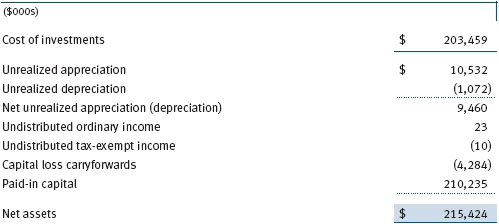
The fund intends to retain realized gains to the extent of available capital loss carryforwards. Because the fund is required to use capital loss carryforwards that do not expire before those with expiration dates, all or a portion of its capital loss carryforwards subject to expiration could ultimately go unused. The fund’s available capital loss carryforwards as of February 28, 2014, expire as follows: $309,000 in fiscal 2016, $1,554,000 in fiscal 2017, and $929,000 in fiscal 2018; $1,492,000 have no expiration.
NOTE 5 - RELATED PARTY TRANSACTIONS
The fund is managed by T. Rowe Price Associates, Inc. (Price Associates), a wholly owned subsidiary of T. Rowe Price Group, Inc. (Price Group). The investment management agreement between the fund and Price Associates provides for an annual investment management fee, which is computed daily and paid monthly. The fee consists of an individual fund fee, equal to 0.10% of the fund’s average daily net assets, and a group fee. The group fee rate is calculated based on the combined net assets of certain mutual funds sponsored by Price Associates (the group) applied to a graduated fee schedule, with rates ranging from 0.48% for the first $1 billion of assets to 0.275% for assets in excess of $400 billion. The fund’s group fee is determined by applying the group fee rate to the fund’s average daily net assets. At February 28, 2014, the effective annual group fee rate was 0.29%.
In addition, the fund has entered into service agreements with Price Associates and a wholly owned subsidiary of Price Associates (collectively, Price). Price Associates computes the daily share price and provides certain other administrative services to the fund. T. Rowe Price Services, Inc., provides shareholder and administrative services in its capacity as the fund’s transfer and dividend-disbursing agent. For the year ended February 28, 2014, expenses incurred pursuant to these service agreements were $91,000 for Price Associates and $43,000 for T. Rowe Price Services, Inc. The total amount payable at period-end pursuant to these service agreements is reflected as Due to Affiliates in the accompanying financial statements.
| Report of Independent Registered Public Accounting Firm |
To the Board of Trustees of T. Rowe Price State Tax-Free Income Trust and
Shareholders of Georgia Tax-Free Bond Fund
In our opinion, the accompanying statement of assets and liabilities, including the portfolio of investments, and the related statements of operations and of changes in net assets and the financial highlights present fairly, in all material respects, the financial position of Georgia Tax-Free Bond Fund (one of the portfolios comprising T. Rowe Price State Tax-Free Income Trust, hereafter referred to as the “Fund”) at February 28, 2014, and the results of its operations, the changes in its net assets and the financial highlights for each of the periods indicated therein, in conformity with accounting principles generally accepted in the United States of America. These financial statements and financial highlights (hereafter referred to as “financial statements”) are the responsibility of the Fund’s management; our responsibility is to express an opinion on these financial statements based on our audits. We conducted our audits of these financial statements in accordance with the standards of the Public Company Accounting Oversight Board (United States). Those standards require that we plan and perform the audit to obtain reasonable assurance about whether the financial statements are free of material misstatement. An audit includes examining, on a test basis, evidence supporting the amounts and disclosures in the financial statements, assessing the accounting principles used and significant estimates made by management, and evaluating the overall financial statement presentation. We believe that our audits, which included confirmation of securities at February 28, 2014 by correspondence with the custodian, provide a reasonable basis for our opinion.
PricewaterhouseCoopers LLP
Baltimore, Maryland
April 16, 2014
| Tax Information (Unaudited) for the Tax Year Ended 2/28/14 |
We are providing this information as required by the Internal Revenue Code. The amounts shown may differ from those elsewhere in this report because of differences between tax and financial reporting requirements.
The fund’s distributions to shareholders included:
- $1,000 from short-term capital gains
- $7,703,000 which qualified as exempt-interest dividends.
| Information on Proxy Voting Policies, Procedures, and Records |
A description of the policies and procedures used by T. Rowe Price funds and portfolios to determine how to vote proxies relating to portfolio securities is available in each fund’s Statement of Additional Information. You may request this document by calling 1-800-225-5132 or by accessing the SEC’s website, sec.gov.
The description of our proxy voting policies and procedures is also available on our website, troweprice.com. To access it, click on the words “Social Responsibility” at the top of our corporate homepage. Next, click on the words “Conducting Business Responsibly” on the left side of the page that appears. Finally, click on the words “Proxy Voting Policies” on the left side of the page that appears.
Each fund’s most recent annual proxy voting record is available on our website and through the SEC’s website. To access it through our website, follow the above directions to reach the “Conducting Business Responsibly” page. Click on the words “Proxy Voting Records” on the left side of that page, and then click on the “View Proxy Voting Records” link at the bottom of the page that appears.
| How to Obtain Quarterly Portfolio Holdings |
The fund files a complete schedule of portfolio holdings with the Securities and Exchange Commission for the first and third quarters of each fiscal year on Form N-Q. The fund’s Form N-Q is available electronically on the SEC’s website (sec.gov); hard copies may be reviewed and copied at the SEC’s Public Reference Room, 100 F St. N.E., Washington, DC 20549. For more information on the Public Reference Room, call 1-800-SEC-0330.
| About the Fund’s Trustees and Officers |
Your fund is overseen by a Board of Trustees (Board) that meets regularly to review a wide variety of matters affecting or potentially affecting the fund, including performance, investment programs, compliance matters, advisory fees and expenses, service providers, and business and regulatory affairs. The Board elects the fund’s officers, who are listed in the final table. At least 75% of the Board’s members are independent of T. Rowe Price Associates, Inc. (T. Rowe Price), and its affiliates; “inside” or “interested” trustees are employees or officers of T. Rowe Price. The business address of each trustee and officer is 100 East Pratt Street, Baltimore, Maryland 21202. The Statement of Additional Information includes additional information about the fund trustees and is available without charge by calling a T. Rowe Price representative at 1-800-638-5660.
| Independent Trustees | | |
| |
| Name | | |
| (Year of Birth) | | |
| Year Elected* | | |
| [Number of T. Rowe Price | | Principal Occupation(s) and Directorships of Public Companies and |
| Portfolios Overseen] | | Other Investment Companies During the Past Five Years |
| | | |
| William R. Brody | | President and Trustee, Salk Institute for Biological Studies (2009 |
| (1944) | | to present); Director, Novartis, Inc. (2009 to present); Director, IBM |
| 2009 | | (2007 to present); Director, BioMed Realty Trust (2013 to present) |
| [157] | | |
| | | |
| Anthony W. Deering | | Chairman, Exeter Capital, LLC, a private investment firm (2004 to |
| (1945) | | present); Director, Brixmor Real Estate Investment Trust (2012 to |
| 1986 | | present); Director and Member of the Advisory Board, Deutsche |
| [157] | | Bank North America (2004 to present); Director, Under Armour |
| | (2008 to present); Director, Vornado Real Estate Investment Trust |
| | (2004 to 2012) |
| | | |
| Donald W. Dick, Jr. | | Principal, EuroCapital Partners, LLC, an acquisition and management |
| (1943) | | advisory firm (1995 to present) |
| 2001 | | |
| [157] | | |
| | | |
| Bruce W. Duncan | | President, Chief Executive Officer, and Director, First Industrial Realty |
| (1951) | | Trust, owner and operator of industrial properties (2009 to present); |
| 2013 | | Chairman of the Board (2005 to present), Interim Chief Executive |
| [157] | | Officer (2007), and Director (1999 to present), Starwood Hotels & |
| | | Resorts, a hotel and leisure company |
| |
| Robert J. Gerrard, Jr. | | Advisory Board Member, Pipeline Crisis/Winning Strategies (1997 |
| (1952) | | to present); Chairman of Compensation Committee and Director, |
| 2013 | | Syniverse Holdings, Inc. (2008 to 2011) |
| [157] | | |
| | | |
| Karen N. Horn | | Limited Partner and Senior Managing Director, Brock Capital Group, |
| (1943) | | an advisory and investment banking firm (2004 to present); Director, |
| 2003 | | Eli Lilly and Company (1987 to present); Director, Simon Property |
| [157] | | Group (2004 to present); Director, Norfolk Southern (2008 to present) |
| | | |
| Paul F. McBride | | Former Company Officer and Senior Vice President, Human Resources |
| (1956) | | and Corporate Initiatives (2004 to 2010) |
| 2013 | | |
| [157] | | |
| | | |
| Cecilia E. Rouse, Ph.D. | | Dean, Woodrow Wilson School (2012 to present); Professor and |
| (1963) | | Researcher, Princeton University (1992 to present); Director, MDRC, |
| 2013 | | a nonprofit education and social policy research organization |
| [157] | | (2011 to present); Member, National Academy of Education (2010 |
| | to present); Research Associate, National Bureau of Economic |
| | Research’s Labor Studies Program (2011 to present); Member, |
| | President’s Council of Economic Advisors (2009 to 2011); Chair |
| | of Committee on the Status of Minority Groups in the Economic |
| | Profession, American Economic Association (2012 to present) |
| | | |
| John G. Schreiber | | Owner/President, Centaur Capital Partners, Inc., a real estate |
| (1946) | | investment company (1991 to present); Cofounder and Partner, |
| 1992 | | Blackstone Real Estate Advisors, L.P. (1992 to present); Director, |
| [157] | | General Growth Properties, Inc. (2010 to present); Director, BXMT |
| | (formerly Capital Trust, Inc.), a real estate investment company |
| | (2012 to present); Director and Chairman of the Board, Brixmor |
| | Property Group, Inc. (2013 to present); Director, Hilton Worldwide |
| | (2013 to present) |
| | | |
| Mark R. Tercek | | President and Chief Executive Officer, The Nature Conservancy (2008 |
| (1957) | | to present); Managing Director, The Goldman Sachs Group, Inc. |
| 2009 | | (1984 to 2008) |
| [157] | | |
| |
| *Each independent trustee serves until retirement, resignation, or election of a successor. |
| |
| Inside Trustees | | |
| |
| Name | | |
| (Year of Birth) | | |
| Year Elected* | | |
| [Number of T. Rowe Price | | Principal Occupation(s) and Directorships of Public Companies and |
| Portfolios Overseen] | | Other Investment Companies During the Past Five Years |
| | | |
| Edward C. Bernard | | Director and Vice President, T. Rowe Price; Vice Chairman of the |
| (1956) | | Board, Director, and Vice President, T. Rowe Price Group, Inc.; |
| 2006 | | Chairman of the Board, Director, and President, T. Rowe Price |
| [157] | | Investment Services, Inc.; Chairman of the Board and Director, |
| | T. Rowe Price Retirement Plan Services, Inc., and T. Rowe Price |
| | Services, Inc.; Chairman of the Board, Chief Executive Officer, |
| | and Director, T. Rowe Price International; Chairman of the Board, |
| | Chief Executive Officer, Director, and President, T. Rowe Price Trust |
| | Company; Chairman of the Board, all funds |
| | | |
| Michael C. Gitlin | | Vice President, Price Hong Kong, Price Singapore, T. Rowe Price, |
| (1970) | | T. Rowe Price Group, Inc., and T. Rowe Price International |
| 2010 | | |
| [52] | | |
| |
| *Each inside trustee serves until retirement, resignation, or election of a successor. |
| Officers | | |
| |
| Name (Year of Birth) | | |
| Position Held With State Tax-Free Income Trust | | Principal Occupation(s) |
| | | |
| Austin Applegate (1974) | | Vice President, T. Rowe Price and T. Rowe Price |
| Vice President | | Group, Inc.; formerly Senior Municipal Credit |
| | Research Analyst, Barclays (to 2011) |
| | | |
| R. Lee Arnold, Jr., CFA, CPA (1970) | | Vice President, T. Rowe Price and T. Rowe Price |
| Vice President | | Group, Inc. |
| | | |
| M. Helena Condez (1962) | | Vice President, T. Rowe Price and T. Rowe Price |
| Vice President | | Group, Inc. |
| | | |
| Patricia S. Deford (1957) | | Vice President, T. Rowe Price and T. Rowe Price |
| Vice President | | Group, Inc. |
| | | |
| G. Richard Dent (1960) | | Vice President, T. Rowe Price and T. Rowe Price |
| Vice President | | Group, Inc. |
| | | |
| Charles E. Emrich (1961) | | Vice President, T. Rowe Price and T. Rowe Price |
| Vice President | | Group, Inc. |
| | | |
| Roger L. Fiery III, CPA (1959) | | Vice President, Price Hong Kong, Price |
| Vice President | | Singapore, T. Rowe Price, T. Rowe Price Group, |
| | Inc., T. Rowe Price International, and T. Rowe |
| | Price Trust Company |
| | | |
| John R. Gilner (1961) | | Chief Compliance Officer and Vice President, |
| Chief Compliance Officer | | T. Rowe Price; Vice President, T. Rowe Price |
| | Group, Inc., and T. Rowe Price Investment |
| | Services, Inc. |
| | | |
| Gregory S. Golczewski (1966) | | Vice President, T. Rowe Price and T. Rowe Price |
| Vice President | | Trust Company |
| | | |
| Charles B. Hill, CFA (1961) | | Vice President, T. Rowe Price and T. Rowe Price |
| Executive Vice President | | Group, Inc. |
| | | |
| Gregory K. Hinkle, CPA (1958) | | Vice President, T. Rowe Price, T. Rowe Price |
| Treasurer | | Group, Inc., and T. Rowe Price Trust Company |
| | | |
| Dylan Jones, CFA (1971) | | Vice President, T. Rowe Price and T. Rowe Price |
| Vice President | | Group, Inc. |
| | | |
| Marcy M. Lash (1963) | | Vice President, T. Rowe Price and T. Rowe Price |
| Vice President | | Group, Inc. |
| | | |
| Alan D. Levenson, Ph.D. (1958) | | Vice President, T. Rowe Price and T. Rowe Price |
| Vice President | | Group, Inc. |
| | | |
| Patricia B. Lippert (1953) | | Assistant Vice President, T. Rowe Price and |
| Secretary | | T. Rowe Price Investment Services, Inc. |
| | | |
| Joseph K. Lynagh, CFA (1958) | | Vice President, T. Rowe Price, T. Rowe Price |
| Executive Vice President | | Group, Inc., and T. Rowe Price Trust Company |
| | | |
| Konstantine B. Mallas (1963) | | Vice President, T. Rowe Price and T. Rowe Price |
| Executive Vice President | | Group, Inc. |
| | | |
| Hugh D. McGuirk, CFA (1960) | | Vice President, T. Rowe Price and T. Rowe Price |
| President | | Group, Inc. |
| | | |
| James M. Murphy, CFA (1967) | | Vice President, T. Rowe Price and T. Rowe Price |
| Vice President | | Group, Inc. |
| | | |
| Linda A. Murphy (1959) | | Vice President, T. Rowe Price and T. Rowe Price |
| Vice President | | Group, Inc. |
| | | |
| Alexander S. Obaza (1981) | | Vice President, T. Rowe Price, T. Rowe Price |
| Vice President | | Group, Inc., and T. Rowe Price Trust Company |
| | | |
| David Oestreicher (1967) | | Director, Vice President, and Secretary, T. Rowe |
| Vice President | | Price Investment Services, Inc., T. Rowe |
| | Price Retirement Plan Services, Inc., T. Rowe |
| | Price Services, Inc., and T. Rowe Price Trust |
| | Company; Chief Legal Officer, Vice President, |
| | and Secretary, T. Rowe Price Group, Inc.; Vice |
| | President and Secretary, T. Rowe Price and |
| | T. Rowe Price International; Vice President, |
| | Price Hong Kong and Price Singapore |
| | | |
| Deborah D. Seidel (1962) | | Vice President, T. Rowe Price, T. Rowe Price |
| Vice President | | Group, Inc., T. Rowe Price Investment Services, |
| | Inc., and T. Rowe Price Services, Inc. |
| | | |
| Michael K. Sewell (1982) | | Vice President, T. Rowe Price |
| Assistant Vice President | | |
| | | |
| Chen Shao (1980) | | Assistant Vice President, T. Rowe Price |
| Assistant Vice President | | |
| | | |
| Douglas D. Spratley, CFA (1969) | | Vice President, T. Rowe Price and T. Rowe Price |
| Vice President | | Group, Inc. |
| | | |
| Timothy G. Taylor, CFA (1975) | | Vice President, T. Rowe Price and T. Rowe Price |
| Vice President | | Group, Inc. |
| | | |
| Julie L. Waples (1970) | | Vice President, T. Rowe Price |
| Vice President | | |
| | | |
| Edward A. Wiese, CFA (1959) | | Director and Vice President, T. Rowe Price |
| Vice President | | Trust Company; Vice President, T. Rowe Price |
| | and T. Rowe Price Group, Inc. |
| |
| Unless otherwise noted, officers have been employees of T. Rowe Price or T. Rowe Price International for at least 5 years. |
Item 2. Code of Ethics.
The registrant has adopted a code of ethics, as defined in Item 2 of Form N-CSR, applicable to its principal executive officer, principal financial officer, principal accounting officer or controller, or persons performing similar functions. A copy of this code of ethics is filed as an exhibit to this Form N-CSR. No substantive amendments were approved or waivers were granted to this code of ethics during the period covered by this report.
Item 3. Audit Committee Financial Expert.
The registrant’s Board of Directors/Trustees has determined that Mr. Anthony W. Deering qualifies as an audit committee financial expert, as defined in Item 3 of Form N-CSR. Mr. Deering is considered independent for purposes of Item 3 of Form N-CSR.
Item 4. Principal Accountant Fees and Services.
(a) – (d) Aggregate fees billed for the last two fiscal years for professional services rendered to, or on behalf of, the registrant by the registrant’s principal accountant were as follows:

Audit fees include amounts related to the audit of the registrant’s annual financial statements and services normally provided by the accountant in connection with statutory and regulatory filings. Audit-related fees include amounts reasonably related to the performance of the audit of the registrant’s financial statements and specifically include the issuance of a report on internal controls and, if applicable, agreed-upon procedures related to fund acquisitions. Tax fees include amounts related to services for tax compliance, tax planning, and tax advice. The nature of these services specifically includes the review of distribution calculations and the preparation of Federal, state, and excise tax returns. All other fees include the registrant’s pro-rata share of amounts for agreed-upon procedures in conjunction with service contract approvals by the registrant’s Board of Directors/Trustees.
(e)(1) The registrant’s audit committee has adopted a policy whereby audit and non-audit services performed by the registrant’s principal accountant for the registrant, its investment adviser, and any entity controlling, controlled by, or under common control with the investment adviser that provides ongoing services to the registrant require pre-approval in advance at regularly scheduled audit committee meetings. If such a service is required between regularly scheduled audit committee meetings, pre-approval may be authorized by one audit committee member with ratification at the next scheduled audit committee meeting. Waiver of pre-approval for audit or non-audit services requiring fees of a de minimis amount is not permitted.
(2) No services included in (b) – (d) above were approved pursuant to paragraph (c)(7)(i)(C) of Rule 2-01 of Regulation S-X.
(f) Less than 50 percent of the hours expended on the principal accountant’s engagement to audit the registrant’s financial statements for the most recent fiscal year were attributed to work performed by persons other than the principal accountant’s full-time, permanent employees.
(g) The aggregate fees billed for the most recent fiscal year and the preceding fiscal year by the registrant’s principal accountant for non-audit services rendered to the registrant, its investment adviser, and any entity controlling, controlled by, or under common control with the investment adviser that provides ongoing services to the registrant were $1,862,000 and $1,651,000, respectively.
(h) All non-audit services rendered in (g) above were pre-approved by the registrant’s audit committee. Accordingly, these services were considered by the registrant’s audit committee in maintaining the principal accountant’s independence.
Item 5. Audit Committee of Listed Registrants.
Not applicable.
Item 6. Investments.
(a) Not applicable. The complete schedule of investments is included in Item 1 of this Form N-CSR.
(b) Not applicable.
Item 7. Disclosure of Proxy Voting Policies and Procedures for Closed-End Management Investment Companies.
Not applicable.
Item 8. Portfolio Managers of Closed-End Management Investment Companies.
Not applicable.
Item 9. Purchases of Equity Securities by Closed-End Management Investment Company and Affiliated Purchasers.
Not applicable.
Item 10. Submission of Matters to a Vote of Security Holders.
Not applicable.
Item 11. Controls and Procedures.
(a) The registrant’s principal executive officer and principal financial officer have evaluated the registrant’s disclosure controls and procedures within 90 days of this filing and have concluded that the registrant’s disclosure controls and procedures were effective, as of that date, in ensuring that information required to be disclosed by the registrant in this Form N-CSR was recorded, processed, summarized, and reported timely.
(b) The registrant’s principal executive officer and principal financial officer are aware of no change in the registrant’s internal control over financial reporting that occurred during the registrant’s second fiscal quarter covered by this report that has materially affected, or is reasonably likely to materially affect, the registrant’s internal control over financial reporting.
Item 12. Exhibits.
(a)(1) The registrant’s code of ethics pursuant to Item 2 of Form N-CSR is attached.
(2) Separate certifications by the registrant's principal executive officer and principal financial officer, pursuant to Section 302 of the Sarbanes-Oxley Act of 2002 and required by Rule 30a-2(a) under the Investment Company Act of 1940, are attached.
(3) Written solicitation to repurchase securities issued by closed-end companies: not applicable.
(b) A certification by the registrant's principal executive officer and principal financial officer, pursuant to Section 906 of the Sarbanes-Oxley Act of 2002 and required by Rule 30a-2(b) under the Investment Company Act of 1940, is attached.
SIGNATURES
Pursuant to the requirements of the Securities Exchange Act of 1934 and the Investment Company Act of 1940, the registrant has duly caused this report to be signed on its behalf by the undersigned, thereunto duly authorized.
T. Rowe Price State Tax-Free Income Trust
| By | /s/ Edward C. Bernard |
| | Edward C. Bernard |
| | Principal Executive Officer |
| | |
| Date April 16, 2014 | | |
Pursuant to the requirements of the Securities Exchange Act of 1934 and the Investment Company Act of 1940, this report has been signed below by the following persons on behalf of the registrant and in the capacities and on the dates indicated.
| By | /s/ Edward C. Bernard |
| | Edward C. Bernard |
| | Principal Executive Officer |
| | |
| Date April 16, 2014 | | |
| | |
| | |
| By | /s/ Gregory K. Hinkle |
| | Gregory K. Hinkle |
| | Principal Financial Officer |
| | |
| Date April 16, 2014 | | |





























